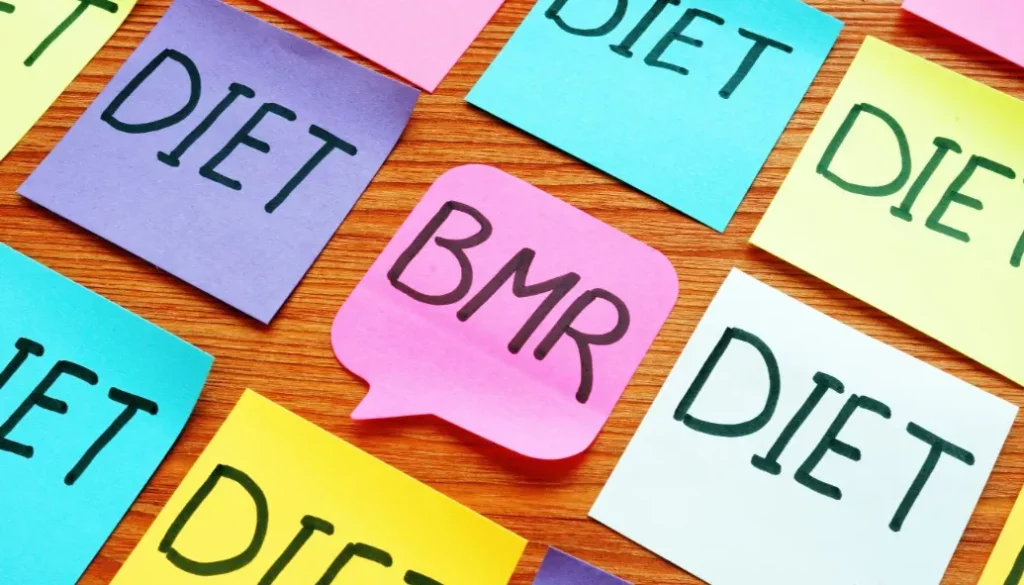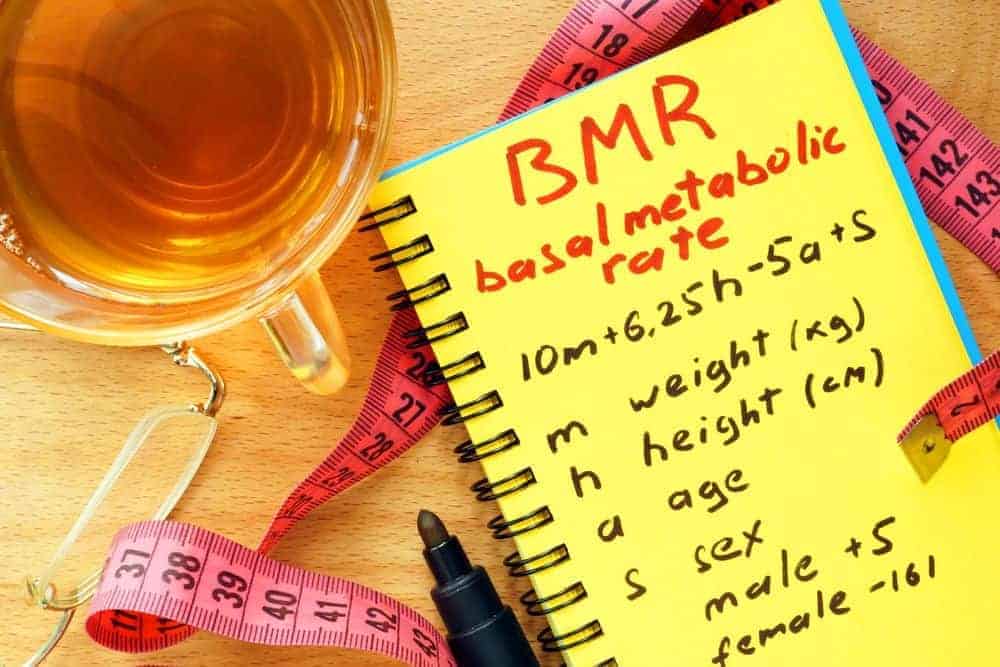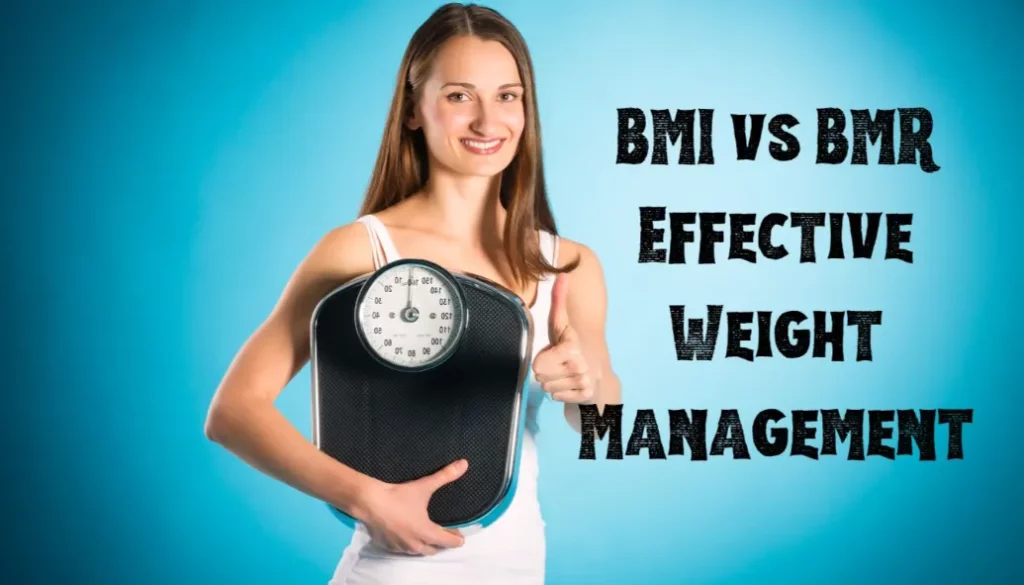How do BMI and BMR work together for weight management? Body Mass Index (BMI) is a screening tool for weight categories, while Basal Metabolic Rate (BMR) calculates your body’s baseline calorie needs. To manage weight, use your BMI to assess your starting point and your BMR to build a precise calorie target for your diet.
🔑 Key Takeaways
- Two Different Tools: BMI screens for weight categories; BMR calculates your body’s baseline calorie burn at rest.
- BMI’s Blind Spot: It doesn’t distinguish between muscle and fat, which can misclassify very muscular individuals.
- Your Metabolic Engine: BMR, calculated using formulas like Mifflin-St Jeor, is the foundation for determining your Total Daily Energy Expenditure (TDEE).
- Actionable Data: Combine them: Use your BMI category to set a weight goal and your BMR/TDEE to create the exact calorie deficit or surplus needed to get there.
- Body Composition is Key: Building lean muscle mass through strength training can improve both your BMI reading and increase your BMR over time.
- Dynamic Metrics: Your BMR decreases with age and is influenced by gender and activity level, requiring periodic recalculation.
Starting a weight management plan requires clarity. I learned that Body Mass Index (BMI) and Basal Metabolic Rate (BMR) are foundational but distinct metrics. BMI gave me a quick snapshot of my weight category based on height. BMR provided the critical number of calories my body burns at complete rest. Understanding both stopped the guesswork and let me build a strategy based on my body’s specific data.
This knowledge shifted my entire approach. BMI highlighted the health risk associated with my weight status. BMR defined the exact energy my body required. Using them together, I moved from generic goals to a personalized plan for nutrition and exercise.
Decoding BMI and BMR: A Comprehensive Overview

Mastering my health started with defining the core metrics. Body Mass Index (BMI) is a simple ratio of weight to height squared, used for initial health screening. Basal Metabolic Rate (BMR), often calculated with the Mifflin-St Jeor Equation, measures the calories needed for basic bodily functions. This was the data I needed to move forward intelligently.
BMI Explained: What It Is and Why It Matters
BMI is a population-level screening tool. The formula is weight (kg) / [height (m)]². My result placed me in a standard category: underweight (<18.5), normal weight (18.5–24.9), overweight (25–29.9), or obesity (≥30). This was a crucial first checkpoint from organizations like the CDC and WHO, but I knew it was just the start.
Steps to Calculate Your BMI Accurately
For manual calculation, follow two steps. First, convert weight to kilograms (lbs ÷ 2.205) and height to meters (inches ÷ 39.37). Second, square the height (height in meters x height in meters) and divide your weight in kilograms by that number. While the National Heart, Lung, and Blood Institute (NHLBI) offers a quick calculator, doing it manually cemented the concept.
Understanding the BMI number was key. A result between 18.5 and 24.9 is associated with lower health risks. Values outside this range signal a need for a deeper health assessment, guiding my initial goal setting.
BMR Unveiled: The Engine of Your Body
BMR represents your body’s idle calorie burn—the energy needed for breathing, circulation, and cell production. This is your metabolic baseline. Knowing this number, derived from the Harris-Benedict or Mifflin-St Jeor equations, was essential for determining my true caloric needs beyond just activity.
How to Calculate Your BMR: A Guide for Precision
For the most accurate 2026 standard, use the Mifflin-St Jeor Equation. For men: BMR = (10 × weight in kg) + (6.25 × height in cm) – (5 × age in years) + 5. For women: BMR = (10 × weight in kg) + (6.25 × height in cm) – (5 × age in years) – 161. I cross-referenced my result with the NHLBI Body Weight Planner for validation.
BMR is the first step. To find your Total Daily Energy Expenditure (TDEE), multiply your BMR by an activity factor (1.2 for sedentary to 1.9 for extremely active). This final TDEE number is the calorie target for maintaining weight. Creating a deficit from this number drives weight loss.
The Synergy of BMI and BMR in Weight Loss

My progress accelerated when I used BMI and BMR in tandem. My BMI identified the “what” (I needed to reduce body fat). My BMR-defined TDEE identified the “how” (I needed a 500-calorie daily deficit to lose about 1 pound per week). This synergy turned abstract goals into a mathematical plan.
The goal evolved from just “weight loss” to “body recomposition.” I tracked my BMI trend over time while using my BMR to fuel workouts and recovery. Balancing calories consumed with my adjusted TDEE became the non-negotiable rule for effective management.
Integrating BMI and BMR for a Tailored Weight Loss Strategy
I created a custom plan by layering data. My BMI category set the destination. My BMR/TDEE mapped the route, giving me a precise daily calorie budget. I focused on improving body fat percentage alongside scale weight, making informed decisions on diet and resistance training.
Adjusting Your Diet Based on BMI and BMR Insights
With my TDEE known, I adjusted my diet strategically. I prioritized whole foods, lean protein, and vegetables to meet nutrient needs within my calorie budget. The key was using my BMR to establish a slight caloric deficit (typically 300-500 calories below TDEE) for sustainable loss without starvation.
This isn’t static. As I lost weight, my BMR decreased. I recalculated my TDEE every 4-6 weeks to ensure my calorie intake continued to support progress. This dynamic adjustment based on metabolic feedback was critical.
Exercise Optimization: Leveraging BMR for Effective Workouts
Understanding my BMR helped me optimize exercise. I knew my body burned a set number of calories at rest. To create a deficit, I incorporated High-Intensity Interval Training (HIIT) and heavy compound lifts to maximize calorie burn during and after workouts (via Excess Post-exercise Oxygen Consumption).
I also timed nutrition around my BMR. I consumed most of my carbohydrates and calories around training sessions to fuel performance and recovery, ensuring my metabolism was supported. This strategic approach made exercise a precise tool for managing my TDEE.
Beyond the Basics: Advanced Insights into BMI and BMR

Advanced understanding reveals limitations and opportunities. BMI estimates body fat from weight and height but fails to assess distribution or muscle mass. BMR provides a personal metabolic snapshot but is influenced by factors like thyroid function. Together, they form a starting point for a broader health dialogue with a professional.
Key Differences Between BMI and BMR
| Feature | BMI | BMR |
|---|---|---|
| Full Name | Body Mass Index | Basal Metabolic Rate |
| Function | Estimates body composition (weight-to-height ratio) | Estimates minimum calorie burn at rest |
| Calculation | Weight (kg) / Height (m²) | Various formulas (e.g., Mifflin-St Jeor) |
| Units | kg/m² | Calories per day |
| Focuses on | Weight and height | Body composition and metabolic processes |
| Limitations | Doesn’t distinguish muscle and fat mass | Estimated value, doesn’t include activity calories |
| Health Indicator | Can indicate potential weight-related health risks (not diagnostic) | Not a direct measure of health |
The Role of Lean Body Mass and Fat in BMI and BMR Calculations
Lean muscle mass is the X-factor. It’s metabolically active tissue that increases your BMR—more muscle means a higher resting calorie burn. However, BMI counts this beneficial weight the same as fat. This is why an athlete can have a “high” BMI but excellent health. The goal shifts to improving body composition, not just lowering BMI.
How to Shift Your Body Composition for Better BMI and BMR Readings
I focused on body recomposition. I implemented progressive strength training 3-4 times per week to build lean mass. Concurrently, I maintained a moderate calorie deficit with high protein intake (1.6-2.2g per kg of body weight) to preserve muscle while losing fat.
This dual approach improved my metrics. As fat decreased and muscle increased, my BMI trended downward toward a healthier range. Simultaneously, the added muscle slowly raised my BMR, making my metabolism more efficient. This is the power of targeting composition.
The Impact of Age, Gender, and Activity Level on BMR
BMR is dynamic. It decreases by 1-2% per decade after age 20 due to muscle loss. Men typically have a 5-10% higher BMR than women of the same size due to greater average muscle mass. Physical activity is the primary variable you control; it directly increases your TDEE and can help preserve muscle mass, mitigating age-related BMR decline.
Practical Applications of BMI and BMR Knowledge
This knowledge is applied in two ways. First, use BMI for initial risk screening and setting a weight range goal. Second, use your BMR/TDEE to engineer your diet. This combination helps prevent the health risks of obesity while ensuring you nourish your body correctly, moving toward a healthier weight sustainably.
When to Use BMI vs. BMR
| Scenario | Use BMI | Use BMR |
|---|---|---|
| Initial assessment of weight-related health risks | Yes | No |
| Monitoring weight changes over time | Yes (with caution) | No |
| Setting general calorie goals for weight management | No | Yes (as a starting point) |
| Understanding individual calorie needs for specific fitness goals | No | Yes |
| Determining the impact of body composition on calorie burning | No | Yes |
Setting Realistic Health Goals Using BMI and BMR Data
Data replaces guesswork. My BMI provided the “why” (move from the overweight to normal weight category). My TDEE, calculated from my BMR, provided the “how much” (consume 2,200 calories daily to lose weight). Goals became specific: “Reduce BMI to 24 by losing 15 lbs, achieved via a 500-calorie daily deficit from a TDEE of 2,700.”
The Dangers of Misinterpreting BMI and BMR: A Cautionary Tale
I once fixated solely on reaching a “normal” BMI. I slashed calories far below my BMR, ignoring my body’s baseline needs. The result was fatigue, muscle loss, and a plummeting metabolism—the opposite of health. This taught me that these metrics are guides for nourishment, not tools for punishment. They must be used together and in context.
Navigating Challenges and Misconceptions
Common myths create barriers. Myth: A high BMI always means unhealthy. Fact: It cannot differentiate muscle. Myth: A low BMR dooms you to obesity. Fact: BMR can be positively influenced by building muscle. Dispelling these required seeking information from authorities like the American Council on Exercise (ACE) and focusing on actionable lifestyle changes.
Myths and Facts: Clearing Up BMI and BMR Confusion
Myth: BMI is a perfect diagnostic tool. Fact: It’s a simple screening metric; further tests like waist-to-hip ratio or DEXA scans are needed for a full picture. Myth: Your BMR is fixed. Fact: It adapts to diet, exercise, and body composition. I now use BMI and BMR as two data points in a broader dashboard that includes strength gains, energy levels, and blood markers.
Addressing High BMI and Low BMR: Strategies for Improvement
A high BMI with a low BMR signals a need for body recomposition. My strategy was twofold. First, introduce resistance training to build metabolically active muscle, which gradually raises BMR. Second, adopt a moderate-calorie, high-protein diet to reduce fat mass, which improves BMI. This combined approach tackles both numbers effectively by changing the body’s underlying composition.
Paving the Way to a Healthier Future
Viewing BMI and BMR as dynamic guides, not final judgments, fosters a sustainable health mindset. This knowledge empowers proactive, informed decisions about nutrition and activity. It’s a foundation for lifelong management, encouraging continuous adaptation based on your body’s feedback.
Innovations in BMI and BMR Calculation: What’s Next?
The future points to personalization. Advances in 2026 include smart scales that estimate body composition via bioelectrical impedance analysis (BIA) and apps that use activity data from wearables like the Apple Watch or Whoop to provide real-time TDEE estimates. Emerging research into metabolic typing may further refine dietary recommendations based on individual BMR profiles.
Empowering Yourself with BMI and BMR Knowledge for Lifelong Health
Mastering these metrics is empowerment. It provides the framework to set realistic goals, understand nutritional needs, and navigate fitness information. This self-knowledge turns health into a personal, data-informed project, setting the stage for informed choices and long-term vitality.
Stepping Toward a Healthier You: The Journey of Understanding BMI vs BMR

The journey integrates both concepts. A normal BMI (18.5–24.9) is a common target. Your BMR, calculated via the Mifflin-St Jeor Equation, is the cornerstone for determining your total daily calorie needs (TDEE). To lose weight, you consume fewer calories than your TDEE. To maintain, you match it.
Effective management requires moving beyond the numbers. Incorporate balanced nutrition and consistent exercise, potentially guided by a certified personal trainer for efficiency. Monitor other metrics like waist circumference and body fat percentage for a complete picture. Applying insights from BMI and BMR enables you to build a structured, effective plan for lasting health.
❓ Frequently Asked Questions
Which is more important for weight loss, BMI or BMR?
BMR is more actionable for weight loss. BMI tells you if you need to lose weight. Your BMR (used to calculate TDEE) tells you exactly how many calories to eat to create the necessary deficit for fat loss. They work best together.
Why is my BMI high but my BMR low?
This typically indicates a higher body fat percentage and lower muscle mass. Muscle burns more calories at rest. A body with more fat and less muscle will show a higher weight (elevating BMI) but a lower resting calorie burn (lower BMR).
How often should I recalculate my BMR?
Recalculate your BMR every 10-15 pounds of weight loss or every 8-12 weeks. Significant changes in weight, muscle mass, or age will alter your metabolic rate. Regular updates ensure your calorie targets remain accurate for continued progress.
Can you have a good BMI but a bad BMR?
Yes, this is “normal weight obesity.” You can have a BMI in the normal range but a high body fat percentage and low muscle mass, resulting in a lower, less efficient BMR. This highlights why body composition is more important than BMI alone.
What’s the most accurate BMR formula in 2026?
The Mifflin-St Jeor Equation is considered the most accurate for the general population in 2026. For greater precision, indirect calorimetry (a metabolic test) measures your exact oxygen consumption, providing a clinical-grade BMR measurement.
Conclusion
Body Mass Index (BMI) and Basal Metabolic Rate (BMR) are not competing metrics but complementary tools. BMI provides the initial health screening and goal post. BMR provides the metabolic blueprint to build a precise nutritional plan. The critical insight is that these numbers are starting points, not finish lines. True health optimization comes from using them to guide improvements in body composition—reducing fat and building lean muscle mass.
Your next step is to calculate both numbers. Use a reliable BMI calculator, then apply the Mifflin-St Jeor Equation to find your BMR. Multiply by your activity factor to get your TDEE. From there, you have a personalized map: adjust your calorie intake based on your goal, and prioritize strength training to improve your metabolic engine. Stop guessing and start calculating. Your data-driven health journey begins now.
References
- Defining Adult Overweight & Obesity – National Institute of Diabetes and Digestive and Kidney Diseases
- About Adult BMI – Centers for Disease Control and Prevention
- Mifflin-St Jeor Equation – National Center for Biotechnology Information
- Health & Fitness Calculators – American Council on Exercise
- Measuring Fatness – Harvard T.H. Chan School of Public Health
- BMI Calculator – National Heart, Lung, and Blood Institute
- Body Composition Assessment Guidelines – American College of Sports Medicine
